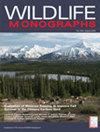The Louisiana black bear (Ursus americanus luteolus) was reduced to a few small, fragmented, and isolated subpopulations in the Lower Mississippi Alluvial Valley by the mid-twentieth century resulting from loss and fragmentation of habitat. In 1992, the United States Fish and Wildlife Service (USFWS) granted the Louisiana black bear threatened status under the United States Endangered Species Act of 1973. Since that time, a recovery plan was developed, a reintroduced population was established, and habitat recovery has occurred. The Recovery Plan states that a minimum of 2 populations must be viable (i.e., persistence probabilities over 100 years >0.95), 1 in the Tensas River Basin and 1 in the Atchafalaya River Basin. Consequently, our objectives were to 1) estimate demographic rates of Louisiana black bear subpopulations, 2) develop data-driven stochastic population projection models, and 3) determine how different projection model assumptions affect population trajectories and predictions about long-term persistence. Our overall goal was to assess long-term persistence of the bear subpopulations in Louisiana, individually and as a whole. We collected data using varying combinations of non-invasive DNA sampling, live capture, winter den visits, and radio monitoring from 2002 to 2012 in the 4 areas currently supporting breeding subpopulations in Louisiana: Tensas River Basin (TRB), Upper Atchafalaya River Basin (UARB), Lower Atchafalaya River Basin (LARB), and a recently reintroduced population at the Three Rivers Complex (TRC). From 2002 to 2012, we radio monitored fates of 86 adult females within the TRB and 43 in the TRC. Mean estimates of annual adult survival for the TRB and TRC were 0.997 and 0.990, respectively, when unknown fates were assumed alive and 0.970 and 0.926 when unknown fates were assumed dead. From 2003 to 2013, we observed 130 cub litters from 74 females in the TRB, and 74 cub litters from 45 females in the TRC. During the same period, we observed 43 yearling litters for 33 females in the TRB and 21 yearling litters for 19 females in the TRC. The estimated number of cubs and number of yearlings produced per breeding adult female was 0.47 and 0.20, respectively, in the TRB and 0.32 and 0.18 in the TRC. On the basis of matrix projection models, asymptotic growth rates ranged from 1.053 to 1.078 for the TRB and from 1.005 to 1.062 for the TRC, depending on how we treated unresolved fates of adult females. Persistence probabilities estimated from stochastic population models based on telemetry data ranged from 0.997 to 0.998 for the TRC subpopulation depending on model assumptions and were >0.999 for the TRB regardless of model assumptions. We extracted DNA from hair collected at baited, barbed-wire enclosures in the TRB, UARB, and LARB to determine individual identities for capture-mark-recapture (CMR) analysis. We used those detection histories to estimate apparent survival (φ), per-capita recruitment (f), abundance (N), realized growth rate (λ), and long-term viability, based on Bayesian hierarchical modeling methods that allowed estimation of temporal process variance and parameter uncertainty. Based on 23,312 hair samples, annual N for females in the TRB ranged from 133 to 164 during 2006–2012, depending on year and how detection heterogeneity was modeled. Geometric mean of λ ranged from 0.996 to 1.002. In the UARB, we collected 11,643 hair samples from 2007 to 2012, from which estimates of N for females ranged from 23 to 43 during the study period, depending on detection heterogeneity model. The geometric mean of λ ranged from 1.038 to 1.059. Estimated N for females in LARB ranged from 69 to 96, and annual λ ranged from 0.80 to 1.11 based on 3,698 hair samples collected during 2010–2012, also depending on year and heterogeneity model. Probabilities of persistence over 100 years for the TRC and TRB based on stochastic matrix projection models that used vital rate estimates from telemetry data were >0.95 for all scenarios. Probability of persistence at the TRB and the UARB based on projection models that used vital rate estimates from CMR analyses ranged from 0.928 to 0.954 and from 0.906 to 0.959, respectively, depending on model assumptions. Data from the LARB were insufficient for a viability assessment. Thus, individual persistence probabilities for TRB and UARB did not meet the strict definition of viability (i.e., >0.95) under some model assumptions. However, the joint probability of bears persisting either in the TRB or UARB was >0.993 assuming individual population dynamics were independent and was >0.958 assuming dynamics were perfectly correlated. Furthermore, including the TRC increased the joint probability of bears persisting somewhere in the TRB, UARB, or TRC to >0.999 based on the most pessimistic individual persistence estimates from those subpopulations. Therefore, if the intent of specifying that 2 subpopulations should be viable was to ensure the persistence of Louisiana black bears somewhere within its historical range, then the viability threshold was met. © 2016 The Wildlife Society.


